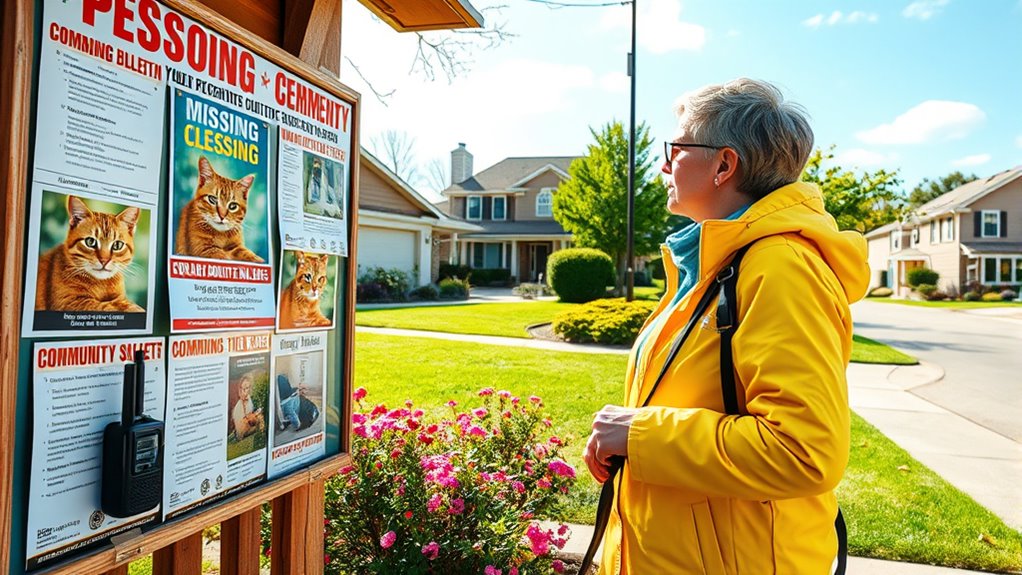In an emergency, use a combination of animal tracking devices like GPS collars and microchips to identify and monitor your pet. Notify neighbors, local shelters, and rescue groups immediately, and share detailed descriptions and recent photos via social media and community alert systems. Posting flyers in key locations boosts visibility. Combining these methods guarantees swift action and increases your chances of reunion. To discover effective approaches that maximize success in urgent situations, keep exploring these strategies further.
Key Takeaways
- Utilize community alert systems and social media to rapidly notify neighbors and expand the search area.
- Distribute physical flyers with recent photos and contact info in high-traffic and local vet locations.
- Combine GPS collars and microchips to enhance tracking and identification efforts for faster recovery.
- Coordinate with local shelters, rescue groups, and authorities to maximize resource sharing and outreach.
- Act swiftly by updating pet descriptions, leveraging multiple channels, and mobilizing community support during emergencies.

Emergencies can strike suddenly, leaving pets frightened and lost. When disaster hits, your first instinct is to find your pet quickly and bring them home safely. Effective emergency communication becomes essential in these moments. One of the most powerful tools you can use is animal tracking technology. GPS collars and microchips allow you to locate your pet accurately, even in the chaos of an emergency. With GPS collars, you can track your pet’s movements in real time, giving you peace of mind and a better chance to recover your furry friend swiftly. Microchips, on the other hand, serve as a permanent form of identification. If your pet gets picked up by someone or found by authorities, a microchip makes it easier for them to be returned to you. Combining these tools with a quick response plan boosts your chances of a successful recovery.
Community alerts are equally critical in emergency situations. When your pet goes missing, notifying your neighbors and local community becomes an indispensable step. Many neighborhoods have alert systems or social media groups dedicated to lost and found pets. By sharing detailed descriptions, recent photos, and your contact information through these channels, you expand the reach of your search exponentially. Community alerts can mobilize neighbors to keep an eye out, check their yards, and report sightings. Some communities also have emergency alert systems that send notifications directly to residents’ phones, which can be invaluable in urgent situations. These alerts often include specific instructions on where to look and how to help, making your community a powerful partner in your pet’s recovery.
In addition to online alerts, don’t underestimate the power of physical flyers posted around your neighborhood, local parks, and veterinary offices. Clear photos, detailed descriptions, and your contact info can catch the eye of someone who might spot your pet. It’s also helpful to coordinate with local animal shelters and rescue groups, informing them of your situation. They can keep an eye out and alert you if your pet is brought in. Combining animal tracking technology with community alerts creates a thorough network that markedly increases your chances of finding your lost pet in an emergency. Staying proactive and leveraging every available resource ensures you’re doing everything possible to reunite with your pet as quickly as possible.
Frequently Asked Questions
How Can I Prevent My Pet From Escaping During Emergencies?
To prevent your pet from escaping during emergencies, make certain they’re in a secure pet enclosure with proper fencing reinforcement. Regularly check fences for weaknesses or damage, and upgrade or repair as needed. Keep gates locked, and consider adding additional barriers if necessary. During chaos, stay calm and keep your pet close or inside a secure area to reduce the risk of escape and ensure their safety.
What Should I Include in a Pet Emergency Kit?
You should include essential items like first aid supplies to treat minor injuries and identification tags with current contact info to help reunite you with your pet quickly. Pack enough water, food, and any necessary medications. Don’t forget a leash, a towel, and copies of your pet’s medical records. This kit guarantees you’re prepared to handle emergencies and increases your chances of a swift recovery if your pet gets lost.
How Do I Handle a Scared or Injured Pet After a Disaster?
When your scared or injured pet faces disaster, stay calm and approach gently. Use trauma management techniques and basic first aid to stabilize injuries, keeping them comfortable and secure. While their fear can be overwhelming, your steady presence offers reassurance. Speak softly and move slowly, prioritizing safety. Remember, your calmness helps reduce their stress, making it easier to provide the necessary first aid and comfort until professional help arrives.
Are There Technological Tools to Help Locate Lost Pets Quickly?
Yes, you can use technological tools like GPS tracking collars and pet microchips to locate your lost pet quickly. GPS collars provide real-time location updates, making it easier to find your pet if they wander far. Microchips, when registered and scanned by shelters or vets, help identify your pet even if they’re found in unfamiliar places. Combining these tools increases your chances of a speedy reunion after a disaster.
How Can Neighbors Assist in Pet Recovery Efforts During Emergencies?
Think of your neighborhood as a woven safety net; neighbors play a crucial role in pet recovery efforts during emergencies. You can organize a community watch, distribute flyers, and use neighborhood alerts to spread the word quickly. Your collective effort creates a ripple effect, increasing the chances of finding your lost pet. Active neighbor involvement transforms a quiet street into a vigilant, caring community, turning despair into hope.
Conclusion
In emergencies, quick action can mean the difference between reunion and loss. Remember, pets are 2.5 times more likely to be recovered if you’ve registered them with a microchip. Stay calm, use social media, and notify local shelters immediately. Your swift response increases your pet’s chances of coming home safely. Keep these strategies in mind, and you’ll be better prepared to act swiftly when it matters most. Your pet’s safe return is worth every effort.










